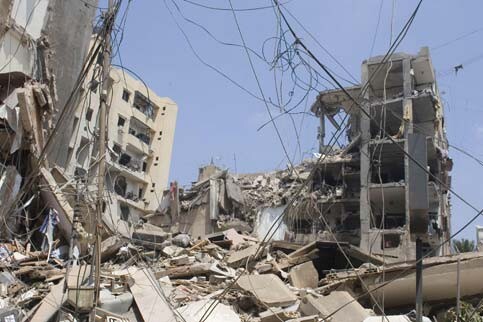The Electronic Intifada 16 August 2006

A general view of a demolished area in the south of the Lebanese capital of Beirut, July 23, 2006. (MaanImages/Raoul Kramer)
I’m always fascinated with the birth of a meme. A new one recently surfaced amid the vitriolic rhetoric that gets dished out by the neoconservative punditry of the Internet: “Hezbollywood.” Google it and be in awe of its (as of this writing) 131,000 results. I’m almost surprised that Google even bothers to ask, “Did you mean: Hollywood?”
Of course not. Right now, right-wing word herders are singing “Hooray For Hezbollywood!” And why not? In one simple word, they can summarize an entire paranoia.
“More Hezbollywood chicanery?” ponders the blogger for the site, My Vast Right Wing Conspiracy, before launching into a screed aimed at updating us all about the “war on Islamofascism.”
“Lights, camera, Hezbollywood!” proclaims Michelle Malkin, a sort of Ann Coulter, “hey, I’ve written books,” wannebe.
“Hezbollywood? Evidence mounts that Qana collapse and deaths were staged,” begins a tirade by Reuven Koret that had been reposted on the website IsraPundit. Koret’s article tops the searches. It’s everywhere, either reposted in whole, or repeated in in segments of others’ Hezbollywood theories.
A meme is a trend that acts more like a contagion. The word originated with the British ethologist and evolutionary theorist Richard Dawkins and refers to the sudden popularity of catch phrases, mannerisms, concepts, songs, fashion and so forth. It’s that hand gesture for “hang loose.” It’s thousands of kids all over the United States singing “hakuna matada” or their parents crooning “don’t worry, be happy” to one another.
The phrase “spider hole” became a meme. After the capture of Saddam Hussein in Iraq, everyone was talking about spider holes. It didn’t matter that no one really understood what a spider hole was. It didn’t matter that what people were talking about was essentially just a hole. No one was saying Saddam was caught hiding in a hole. Everyone talked about him being caught in a “spider hole.” The idea that he was discovered in a hole at all is a meme. It’s just taken for granted and repeated in spite of testimony that came out shortly after his capture that suggested he wasn’t in the hole, but in the little house nearby.
There are organic memes. Someone somewhere started shortening “laugh out loud” into “LOL” in their emails and then everyone was doing it and then it became really annoying. There are also manufactured memes. That Saddam had weapons of mass destruction was a manufactured, popularized meme. That the Sept. 11, 2001 attacks had an Iraqi connection also was an orchestrated meme. There wasn’t any connection, but polls shortly after the attacks showed that a growing number of Americans thought there was one. Where did that come from?
Like all forms of ubiquity, memes can range from being merely pesky to downright dangerous. Holocaust denial is a particularly chilling meme, yet there are scads of people out there who will express doubts that the systematic killing of six million Jews took place. There are all sorts of memes in the American consciousness about Arabs and about Muslims. People see a hijab and they immediately think the wearer is being oppressed. They see a group of people bowing east in prayer on rugs and think “fundamentalists.”
The notion behind the Hezbollywood meme is that photos and news footage of civilian casualties caused by Israeli attacks in Lebanon are either staged events or the work of digital manipulation, and that it’s all Hezbollah’s doing.
There are literally thousands of images being made of the destruction in Lebanon by hundreds of photographers. They’re with news agencies or are freelancers and individual Lebanese civilians who happen to have a camera handy. If this accusation were true, Hezbollah would have to be working on a massive scale in an effort that would require thousands of highly trained media- and computer-savvy technicians. It would be a special effects team that would make George Lucas jealous. And the idea ignores the reality that Hezbollah had slightly more pressing matters to attend to at the time, what with missile attacks and a ground war going on.
These things didn’t matter, though. The idea had taken off. At least it seemed to. From reading a sampling of Hezbollywood references, it looked to me that the concept of falsified footage of what’s going on in Lebanon was an attempt to manufacture a meme. Many of the posts found on blogs and forums had a repetitious quality. The same catch phrases, word choices and speculations were in many of them.
A lot of the the talk about alleged Hezbollywood fakery centers on the air attack in Qana on July 30 which destroyed an apartment building and, according to Human Rights Watch and the Red Cross, killed 27 civilians, many of them children.
Many website posts cited a July 31 column from the website Israel Insider by Koret, which looks to be where the word “Hezbollywood” seems to have originated.
The article referred to “an unexplained 7 to 8 hour gap between the time of the helicopter strike and the building collapse” as proof Hezbollah had actually demolished the building in question for better footage. Since then, people have been posting items about “an unexplained gap of about seven hours” in some blogs and an “eight hour gap” in others.
Koret has another, even more cynical hypothesis, which he floats in the same article: That Hezbollah members “planted” bodies in the wreckage of the Qana apartment which they took from a nearby morgue ,and then engineered “a ‘controlled demolition’ to fake another Israeli attack.” No building engineers or otherwise qualified specialists are cited and no eyewitness accounts are offered to support this assertion. No official coroners or medical experts, either. But that’s not the point. It was a callous, simple way to exonerate the attackers while simultaneously taking a shot at the attacked. The parents who thought their children were killed in that building must be relieved that Koret was able to wipe their deaths from existence.
Some web pundits focused on reports which asserted “there was little blood.” One stated that, “there is the question as to why some of these victims appeared to have been cellophane shrink wrapped, as if they had just been purchased at the local Piggly Wiggly - all that was missing was the price tag.”
The idea was catching on, though. It reached the point that the Associated Press, Agence France-Presse and Reuters felt the need to issue a public statement in defense of their work. It didn’t help. They were hit back with an image out of Beirut that had been allegedly altered by a Reuters photographer. That one image, out of thousands, was proof enough as far as these critics were concerned. The rest had to be fake as well. The bloggers began giving themselves little cyber pats on the back. “Just imagine if there were no bloggers to bring this out in the open,” one commenter posted on an entry dissecting CNN coverage.
“Thank God for persistent bloggers,” blogged persistent blogger Malkin.
The Hezbollywood meme rests on a tripod of concepts. The first is a meme itself. It’s the idea popular among many conservative and liberal partisans that bloggers are collectively the new, scruffy underdog journalists battling the entrenched, outdated Big Media. Both deride corporate media as being too liberal or two conservative. Only on the left are a few who simply say it’s too corporate.
The second leg is just old fashioned racism that persists in the subconsciousness of many Westerners: That Arabs are universally less trustworthy and are more prone to extremism and hatred than the rest of us. Such a notion disregards who was responsible for all previous occupations of the Middle East in centuries past, and who was really behind the killing of all those Jewish people in Europe not so terribly long ago.
The third is ideology. It’s feeling safe in the belief that the side you support can do no wrong because you believe it has the moral high ground. Ideologies have a strange way of inoculating their adherents from harsh realities. Too many graphic photos were depicting the horrors taking place in Qana and elsewhere in Lebanon. Coverage was streaming out of Israel concurrently, showing the destruction that Hezbollah rockets were having. For once though, and just for a brief period, the imbalance in the coverage of a Middle East conflict was inherent to where most the destruction was actually taking place. For those who cannot abide even the fleeting appearance that Israel was behaving “disproportionately,” as some tepid criticism by a growing number of observers had suggested, the battle had to move to public perception.
At the center of the Hezbollywood rests a lie, and not a particularly original one. A small, rabid group of individuals a number of years ago perpetuated an anti-Semitic hoax by pushing the “The Protocols of the Elders of Zion” as something approaching authentic. It was their way of justifying the barbarous treatment of Jews in Europe. Still today there are people who take The Protocols seriously. It was a fake, as are the recent perfidious suppositions regarding conspiracies to counterfeit massacres in Lebanon.
Folks similar to those who promoted The Protocols also scrutinized photos and films of concentration camps and mass graves uncovered in Germany, Poland and around Europe and suggested that those too were falsified. The people behind those attempts have some eerily common traits with the individuals who have rushed to discredit evidence of human rights violations in the West Bank, Gaza, Lebanon, Iraq, Afghanistan and elsewhere: In the wake of overwhelming evidence, they employ hatred, fear, stereotype and blind speculation.
Does it work?
The comment by someone on the blog Hotair.com may provide some insight into the answer: “My God! These people have no shame. Why should (we) show any remorse at killing them?”
Andrew Ford Lyons is an English teacher, writer and activist with the International Solidarity Movement.
Related Links



